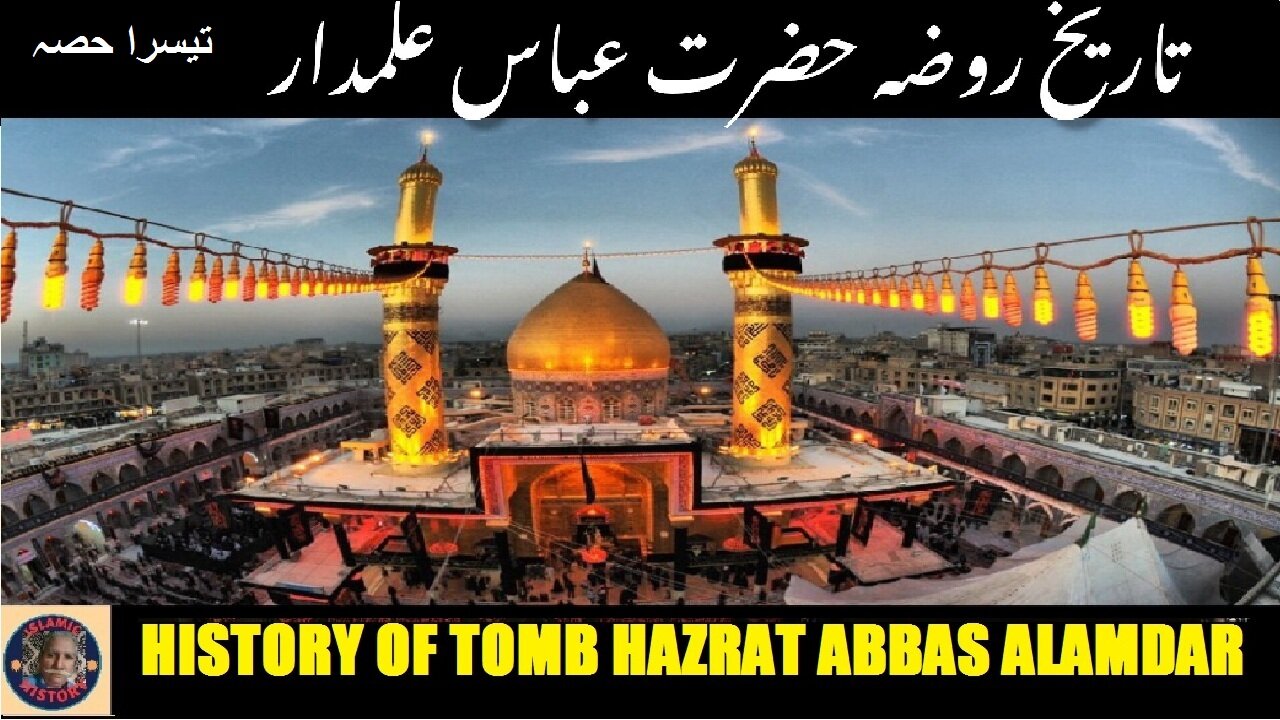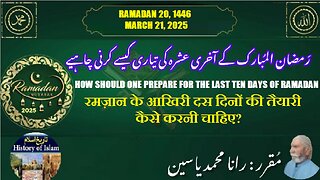Premium Only Content

P-3 History of Tomb the Hazrat Abbas کربلا میں واقع حضرت عباس علمدار رضی اللہ عنہ کے مقبرہ کی تاریخ
@islamichistory813 #TombOfAlAbbas #KarbalaHistory #IslamicHeritage
Part-3
History of Holiest site Tomb the Al-Abbas in Karbala
Dekhti aankhon aur suntay kanon ko Asslamoalaikum, sisters brothers and elders In this Islamic informative video Part-3, we are describing the remaining history of the Tomb of Al-Abbas in Karbala, a site that holds profound meaning for millions of Muslims worldwide. The video highlights the life and valor of Al-Abbas, emphasizing his contributions during the tragic events of the Battle of Karbala. By examining historical texts and contemporary perspectives, we aim to provide a comprehensive overview of the significance of this holy site. We are describing history of tomb and also bravely incidents in Karbala of Hazrat Abbas Alamdar (RA) in Nive parts. so please watch all parts. and if you like then please share to your friends so that they also be benifit.
River Al-Alqami
River al-Alqami was a stream branching from the Euphrates. It was passing by and irrigating the lands of Karbala. It was the only river in that area.
Neither the geography scholars nor have the historians referred to the location and history of this river. Moreover, Imam as-Sadiq (a) did not refer to this name as he mentioned the location of the martyrdom of al-’Abbas. However, this name was mentioned in many narratives recorded in authentic, trustworthy reference books.
At-Turaihi, in his book titled al-Muntakhab page 91, writes down a narration in which there is a reference to the River al- Alqami. A narration recorded in Medinat ul-Ma’aajiz in Chapter 127 on page 263; it includes a reference to the River al-Alqami.
Ibn Shahrashub, in his book titled al-Manaaqib; 2/190, records the narration of al-Mutawakkil’s orders of digging the tomb of Imam al-Husayn (a). In this narration, he refers to the River al-Alqami.
In Mezar ul-Bihar page 161, a narration of a special Ziyara to the tomb of al-’Abbas is recorded. This narration begins with:
“If you intend to visit Karbala, you should first reside at the shore of the River al-Alqami, undress yourself, wash…etc.”
This narration is quoted from the famous books of Ziyara compiled by Sheikh al-Mufid and al-Mash’hadi.
All these narrations prove that the name of al-Alqami was known for everybody for many decades. Nevertheless, the reason behind this name is not known. Some mentioned that a man from the tribe of Alqama dug that river.
In his book titled Zeenat ul-Majalis and written in AH 1004, Sayyid Majduddin Muhammad Majdi records that the vizier Saeed ibn al-Alqami gave his orders of ruining that river after he had heard the saying of Imam as-Sadiq (a) addressing to the river:
“How is it that you are still flowing after my grandfather was prevented from drinking from you?”8
As the River al-Alqami was ruined, the gardens of Kufa were damaged, because they were irrigated from its water.
Burial Place of the Head
Various reports have been narrated about the places where the heads of the martyrs of Karbala were buried.
Historians have, almost unanimously, agreed that Omar ibn Saad gave the orders of beheading the bodies of the warriors of Imam al-Husayn’s army. They were seventy-eight heads carried by the tribes and individuals of Yazid’s army.9 These heads were then taken to Kufa. Ubaidullah ibn Ziyad, the governor of Kufa, later sent these heads with the caravan of the captives to Syria.
After a long series of events the stars of which were Imam ‘Ali ibn al-Husayn Zayn ul-Abidin and his aunt Zaynab daughter of Imam ‘Ali in Damascus, Yazid anticipated revolution of people against him. He therefore had to allow the Imam and the captives to go home and respond to all their demands. They demanded Yazid to give them the head of Imam al-Husayn so as to attach it to the body in Karbala.
Historians, though most of them did not refer to the other heads, have mentioned that Yazid gave all the heads to Imam Zayn ul-Abidin who attached them to the bodies on the twentieth of Safar. The head of al-’Abbas was one of these.10
This report seems to be the most acceptable if we take in consideration the events and motives that obliged Yazid to respond to the demands of Imam Zayn ul-Abidin who would surely ask for all the heads so as to attach them to the bodies.
Nevertheless, there are other narrations:
In his A’yaan ush-Shi’a, 4/290, Sayyid Muhsin al-Amin records:
“In AH 1321, I saw a place in the cemetery known as Maqbarat Bab us-Sagheer in Damascus on whose door there was a rock with the script: This is the burial place of the heads of al-’Abbas ibn ‘Ali, ‘Ali al-Akbar ibn al-Husayn, and Habib ibn Muzhahir… A few years later, that burial place was destroyed. When it was reconstructed, that rock was taken away and a tomb was built inside that burial place. On that tomb the names of many individuals whom were martyred in Karbala with Imam al- Husayn (a) were engraved. In fact, that tomb contained only the three aforementioned heads…etc.”
Had Sayyid al-Amin skimmed through the book of Habib us - Siyar, he would have believed that these three heads were not buried in that cemetery in Damascus. Anyhow, those who wrote the names of these three heroes of Karbala on that rock in the cemetery had other intentions. Finally, it is not unlikely that these three heads were crucified, not buried, at that place.
So tomorow we will be described Part-4 of History of Holiest site Tomb the Al-Abbas in Karbala .Allah Hafiz
=======================
-
 9:08
9:08
ISLAMIC HISTORY
13 hours agoHow should one prepare for the last ten days of Ramadan رمضان کے آخری عشرہ کی تیاری کیسے کرنی چاہیے؟
16 -
 31:38
31:38
Michael Franzese
2 hours agoTony Accardo: The Genius That Built Chicago’s Most Powerful Empire
8.17K1 -
 45:40
45:40
BonginoReport
4 hours agoCritics Give Disney’s Feminist “Snow White” a Rotten Apple (Ep.10) - Nightly Scroll w Hayley 03/21/2025
70.2K103 -
 1:47:40
1:47:40
Kim Iversen
6 hours agoWhy Did Sarah Ashton-Cirillo Help Jail Gonzalo Lira? His Side of The Story
66.9K129 -
 9:00:23
9:00:23
Dr Disrespect
9 hours ago🔴LIVE - DR DISRESPECT - TRIPLE THREAT CHALLENGE - WZ, PUBG, FORTNITE
180K29 -
 12:23
12:23
Adam Does Movies
4 hours ago $0.69 earnedSnow White (2025) Movie Review - Disney Does It Again!
9.34K9 -
 1:33:43
1:33:43
Tucker Carlson
3 hours agoSteve Witkoff’s Critical Role in Negotiating Global Peace, and the Warmongers Trying to Stop Him
66.1K81 -
 15:56
15:56
T-SPLY
7 hours agoDemocrats Are Now Lying About The Department Of Education Shutdown
65.3K45 -
 1:08:59
1:08:59
Edge of Wonder
6 hours agoJFK Files Update: The Secret $100K Bounty
11.7K3 -
 57:42
57:42
Sarah Westall
3 hours agoJFK Document Dump – What’s New, What’s Not – JFK & National Security Expert Larry Hancock
27.7K2